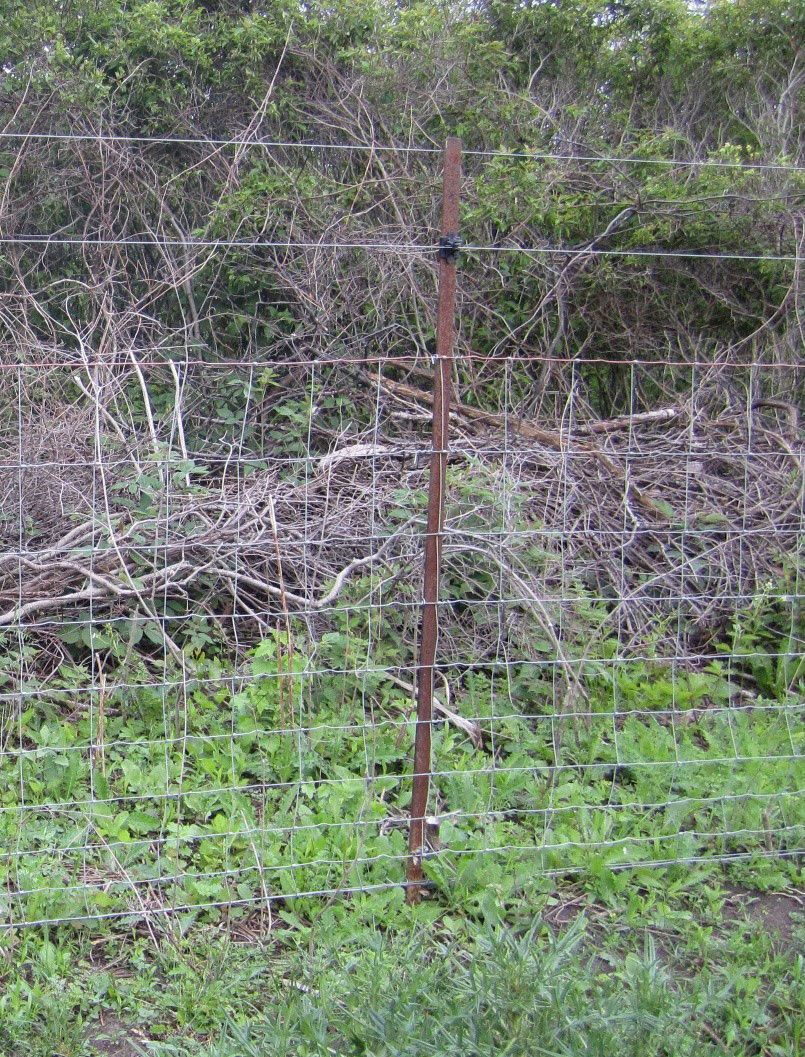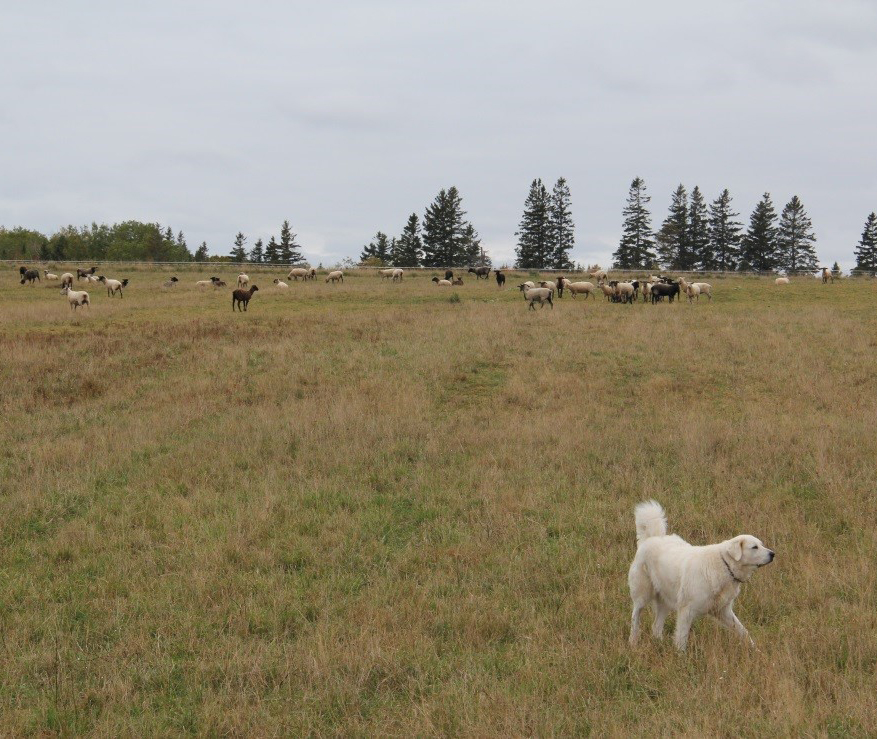Tools for mitigating losses due to coyote predation
Learn strategies and tools to prevent coyote predation on your livestock.
ISSN 1198-712X, Published May 2021.
Introduction
Predation is an ongoing threat on sheep, beef and goat operations, but there are proactive steps that can be implemented. It should be noted that even with the best prevention strategies in place, predation can and/or will still occur. The same method will not be effective for every farm. Most successful predator control programs use an integrated approach that would include good husbandry with effective control methods. When considering prevention practices, it is important to consider the level of predation, the dollar value of loss, time of year, location, past history, cost of each predation prevention strategy and the amount of protection offered
Predation prevention tools
Predation prevention tools may include:
- fencing
- livestock guardian animals (dog, donkey, llama)
- hunting
- trapping
- novelties and non-lethal deterrents (lights, radio, bells, fladry, etc. as well as commercial deterrents such as Nite Guard Solar, Foxlights, etc.)
- using protected fields or enclosed areas for lambing, calving, kidding
- rotational grazing
- regular inspection
- night enclosures
- appropriate deadstock disposal in accordance with provincial regulations
It should be noted that night time enclosures are not feasible for large flocks or herds of grazing livestock rotated over a large land base or on rented land. If larger flocks or herds were to be confined at night, mis-mothering is likely to occur as well as potential increased exposure to diseases such as internal parasites and coccidiosis, to name a few.
Below is a brief summary of some predation tools to mitigate losses against coyote predation.
Fencing
Several options exist when looking to build a new fence or adding to the current fence for predator control measures. The Predation Management with a Focus on Coyotes Manual, published by the Alberta Lamb Producers, recommends that fencing to deter coyotes have the following features:
- Prevent coyotes from getting through the fence. Ensure that fence openings in non-electric fences are no larger than 15 cm by 15 cm (6 in. by 6 in.) and smaller if woven wire is not high tensile.
- Prevent coyotes from crawling under the fence. Place the bottom wire of the fence as close to the ground as possible with appropriate tension to prevent “pushing under.”
- Prevent coyotes from jumping or climbing over the fence. Make the height at least 1.70 m (5 ft 6 in.). Consider brace assembly designs to minimize toe-hold opportunities.
- Prevent coyotes from getting through gateways. Ensure gates are as high as the fence and that bar or wire spacings prevent coyotes from squeezing through. Keep traffic ruts levelled out and the clearance between the gate and ground to a minimum.
footnote 2
Electric fences
Electric fences can be effective for predator control, however, some coyotes may have learned how to get through the fence in areas where electric fencing is extensively used. Perimeter fences must be at least five strands of electric with alternative live and ground wires. Anything less is not effective in deterring coyote predation, especially if predation has already occurred on the farm.
An electric fence that was found to be very effective by Alberta farmers is the nine-wire, anti-coyote electric fence
Net-wire fences
Another effective fence is a modified net-wire fence. Use galvanized 12.5 gauge high-tensile mesh wire with spacings in the mesh no larger than 15 cm by 15 cm (6 in. by 6 in.). Add electric strands to the top of the fence to make the overall height 1.70 m (5 ft 6 in.). When constructing the fence, ensure that the fence is tight to the ground to prevent "squeeze under" spots (Figure 1). If coyotes are digging under the fence, consider adding a 12.5-gauge high-tensile hot wire outside of the fence 10–15 cm (4–6 in.) above ground and 10–20 cm (4–8 in.) out from the fence
When using a net-wire fence with goats, it is a good idea to add an off-set electric fence wire on the inside of the page wire (electric wire is off-set 15 cm (6 in.) from the net-wire fence) to prevent the goats from climbing or trying to push under. Doing this will increase the lifespan of the fence.

Figure 1. Modified net wire fence.
Electric net fencing
Electric net fencing may be an alternate option for grazing sheep and goats in some situations such as grazing on rented land, grazing on hay-aftermath or cover crops. This fence is available in different heights and can be effective at reducing predation, since the animals and fence are continuously moving to different locations and fields. The frequent changes offer some degree of protection by delaying habituation to the fence. However, in some cases, coyotes apparently learned to jump the electric net fences as no digging under was found and good voltage levels were maintained
Additional information and construction details on fencing for predator control can be found in:
- Ontario Ministry of Agriculture, Food and Rural Affairs (OMAFRA) fact sheet Fencing options for predator control
- Alberta Agriculture’s Agri-Facts Protecting livestock from predation with electric fences
- Alberta Lamb Producers Predation management with a focus on coyotes manual
Livestock guardian animals
Livestock guardian dogs are the most popular choice for predator protection on sheep and goat farms. The major benefit to having livestock guardian dogs is the ability to have multiple dogs per field or farm to monitor the flock or herd. This can help with keeping losses in check. Donkeys and llamas can be effective as a predator control means and could be used with livestock guardian dogs. Beef farms may opt to use a donkey as opposed to a dog since the donkey can eat the same feed as the cattle. Often, fences on a beef farm will not contain a livestock guardian dog.
Before choosing a livestock guardian animal (Figure 2), it is important to note the advantages and disadvantages to each and select a protection method that is best suited to the operation. Cost and annual expenses of a guardian animal must be considered, including initial investment costs, annual feed, de-worming, vaccinations and hoof trimming (if applicable). Livestock guardian animals will not solve all predation problems but will help reduce predation losses. Guardian animals combined with good fences and management strategies can assist in the constant struggle against predation.
More information on using guardian donkeys can be found in the OMAFRA fact sheet Guidelines for using donkeys as guardian animals. Information on the care of livestock guardian dogs is provided in Livestock guardian dogs and their care in winter.

Figure 2. Livestock guardian dogs are one option for predation control.
Hunting and trapping
Hunting and trapping can be useful to target problem predators. Certain regulations and local bylaws must be followed. Farmers may also hire an agent such as a licensed hunter or trapper to act on their behalf.
More details on hunting can be found under the Fish and Wildlife Conservation Act, 1997, in Section 31, Protection of Property.
For more information on trapping regulations, see the Fish and Wildlife Conservation Act, 1997, Ontario Regulation 667/98 Trapping.
One tool that was approved as of January 1, 2016, is the relaxing cable restraint for use by licensed trappers and trained farmers on their own property to address problem coyotes and wolves. Certain seasonal and geographic restrictions apply to the use of this tool. There are also technical specifications guiding the design of this restraint to help avoid capture of non-target animals. For areas where relaxing cable restraints can be used in Ontario, regulations, components of a relaxing cable restraint and best management practices, see Best Management Practices for Use of Relaxing Cable Restraints in Ontario.
For full details on the amendment to Ontario Regulation 667/98 of the Fish and Wildlife Conservation Act, 1997, around the use of relaxing cable restraints, go to the Environmental Registry of Ontario archive and search ER# 012-4735.
Non-lethal deterrents
Non-lethal deterrents can include a variety of items or tools. Some commercially available devices include Foxlights, Nite Guard Solar and motion-activated ultrasound deterrents. Other solutions include fladry (flags, caution tape or aluminum pie plates tied or hung on the perimeter fence), radio, lights and objects that are moved around the field such as scarecrows and vehicles. Combinations of these techniques can also be used.
Coyotes and other predators can quickly adapt to devices and overcome their initial fear of the novel object. Changing and moving deterrents frequently will help prevent coyotes from becoming acclimatized to a set pattern
Non-lethal commercial deterrents are often cost prohibitive for use over a large land base, but they may help during vulnerable periods. Deterrents offer focused protection for a short time, for example, when ewes are lambing on pasture.
Conclusion
The type and timing of predation prevention tools used will depend on the predation level on a farm. One method will not be effective for every farm. Producers must choose the options that will work for their operation. Coyotes are extremely smart and will continually adapt to new mitigation measures. It is not possible to eliminate all predation. However preventive measures can help reduce the overall predation rate on-farm.
References
- Acorn, R.C., and Dorrance, M.J. Coyote Predation of Livestock. Edmonton: Alberta Agriculture, Food and Rural Development, 1998.
- Alberta Agriculture, Food and Rural Development. Bourne, J. and Merrill, P. Protecting Livestock from Predation with Electric Fences. Factsheet Agdex 684-7, 2005.
- Alberta Lamb Producers. O’Brien, A. Predation Management with a Focus on Coyotes. 2014.
- O’Brien, A. Sheep Management Practices Can Influence Predation. Queen’s Printer for Ontario. 2016. (document no longer available)
This fact sheet was written by Jillian Craig, Small Ruminant Specialist, OMAFRA, Lindsay.
Footnotes
- footnote[1] Back to paragraph Acorn, R.C., and Dorrance, M.J. Coyote Predation of Livestock. Edmonton: Alberta Agriculture, Food and Rural Development, 1998.
- footnote[2] Back to paragraph Alberta Agriculture, Food and Rural Development. Bourne, J. and Merrill, P. Protecting Livestock from Predation with Electric Fences. Factsheet Agdex 684-7, 2005.
- footnote[3] Back to paragraph Alberta Lamb Producers. O’Brien, A. Predation Management with a Focus on Coyotes. 2014.
- footnote[4] Back to paragraph O’Brien, A. Sheep Management Practices Can Influence Predation. Queen’s Printer for Ontario. 2016. (document no longer available)